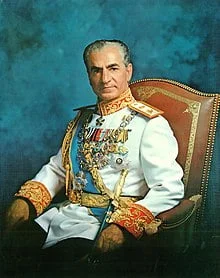Real Celebrities Never Die!
OR
Search For Past Celebrities Whose Birthday You Share

source:wikipedia.org
Mohammad Reza Shah
Birthday:
26 Oct, 1919
Date of Death:
27 Jul, 1980
Cause of death:
lymphatic cancer
Nationality:
Iranian
Famous As:
King
Age at the time of death:
60
Early Life
Born on October 26, 1919, in Tehran, Iran, Mohammad Reza Pahlavi was the son of Reza Shah Pahlavi and Tadj ol-Molouk. In 1925, his father established the Pahlavi dynasty and became the Shah of Iran. Mohammad Reza received his education in Switzerland and returned to Iran in 1935. In 1941, at the age of 21, he was appointed crown prince when his father was forced to abdicate due to British and Soviet occupation during World War II.
Challenges During Early Reign
During the early years of his reign, Mohammad Reza Pahlavi faced challenges from various political factions and popular demands for greater democracy. In 1951, Prime Minister Mohammad Mossadegh led the nationalization of Iran’s oil industry, which had been under British control. This move was met with international opposition and economic sanctions, leading to a political crisis that threatened the Shah’s rule.
The 1953 Coup
In 1953, with the assistance of the United States and British intelligence agencies, Mohammad Reza Pahlavi orchestrated a successful coup against Mossadegh’s government. This coup, known as Operation Ajax, reinstated the Shah’s authority and consolidated his power. Subsequently, he embarked on a series of modernization efforts aimed at transforming Iran into a developed nation. His programs focused on infrastructure development, industrialization, and social reforms.
The White Revolution
In 1963, the Shah introduced the White Revolution, a series of reforms aimed at modernizing Iran’s political, economic, and social structures. These reforms included land redistribution, women’s suffrage, and educational reforms. The Shah’s ambitious economic policies aimed to diversify the economy, reduce dependence on oil revenue, and promote industrialization. Despite initial successes, these reforms faced opposition from traditionalists and religious clerics, leading to increased social tensions.
Mounting Opposition and Social Tensions
As the 1970s progressed, dissatisfaction with the Shah’s autocratic rule and economic disparities intensified. While the Shah’s modernization efforts transformed Iran into a regional power, they also fueled corruption, inequality, and human rights abuses. Political dissent was suppressed, and the Shah’s secret police, known as SAVAK, was notorious for its brutal tactics. These repressive measures alienated large segments of the population, including religious groups and intellectuals.
Mohammad Reza Pahlavi's Quote's
The Islamic Revolution
In 1979, a popular uprising, led by religious leader Ayatollah Ruhollah Khomeini, culminated in the Islamic Revolution. The revolutionaries demanded an end to the Shah’s rule and the establishment of an Islamic republic. Mohammad Reza Pahlavi fled the country on January 16, 1979, seeking medical treatment abroad. Despite attempts to regain control, he was unable to return to Iran and spent the remainder of his life in exile.
Name:
Mohammad Reza Pahlavi
Popular Name:
Mohammad Reza Shah
Gender:
Male
Cause of Death:
lymphatic cancer
Spouse:
Place of Birth:
Tehran, Qajar Iran
Place of Death:
Cairo, Egypt
Occupation / Profession:
Personality Type
Executive: Excellent administrators, unsurpassed at managing things – or people. He was a powerful administrator and because of his management skills he was able to face the challenges in his life and carrier.
Pahlavi was a skilled pilot who flew jets himself and had a deep interest in military technology
He became Shah of Iran at just 22 years old in 1941, when his father was forced to abdicate after the British and Soviet invasion of Iran during World War II
Pahlavi survived multiple assassination attempts, including one where he was shot five times but miraculously survived
He was the second and last monarch of the House of Pahlavi to rule within Iran
